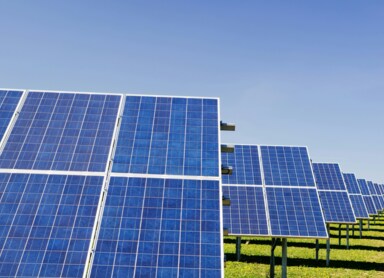What is Decarbonization? Meaning and Examples
Each company must find its own business model in which it will be possible to reconcile business goals, stakeholder expectations, and environmental protection. We can help you with this! At Reo.pl, we support entrepreneurs by offering attractive PPAs, assistance in implementing ESG strategies, and favorable balancing of electricity.
Decarbonization of the economy is one of the global environmental goals, relevant not only in the European Union but also worldwide. How to carry out an energy transition in a company and what does decarbonization of the economy mean?
Decarbonization – definition and significance
Decarbonization is a term that can be applied to the economy and energy sector in general, but it can also be discussed locally, in relation to specific industries, or even individual companies. In the broadest sense, decarbonization means striving to reduce, and as much as possible, completely eliminate carbon dioxide emissions into the atmosphere. This compound is primarily produced as a result of processing non-renewable fossil fuels such as oil, hard coal, and lignite, contributing to negative environmental changes, including global warming and water acidification.
Over the past decades, the importance of a coal-based economy has systematically and intensively increased. This has led to a situation where most countries base their infrastructure on the extraction of fossil fuels. Although Poland cannot compete in terms of emissions with such economic giants as the United States or China, data published for 2019 shows that as a country, we are in the 5th, not very honorable, place in the entire European Union regarding total CO2 emissions1. Only Italy, France, the United Kingdom (which was a member of the Community at the time of the compilation), and Germany surpass us.
Why are decarbonization and energy transformation so important for your company? Greenhouse gases gradually contribute to far-reaching environmental changes. This not only affects the company's image as a conscious market participant actively working towards environmental protection but also allows for the fulfillment of legal requirements within non-financial reporting.
Decarbonization of the economy – goals and strategies
Decarbonization of the economy has become one of the main goals of the European Union's climate policy. The Community has committed to achieving climate neutrality by 2050 by reducing greenhouse gas emissions (GHG) and implementing actions aimed at balancing CO2 production that cannot be achieved through increased natural GHG absorption.
It is worth remembering that this assumption is not just a postulate but has become legally binding as part of Regulation No. 2021/1119 2, embodying the philosophy of the European Green Deal. Simultaneously, a milestone to motivate member states to reduce greenhouse gas emissions is the commitment to reduce their production by 55% compared to 1990 levels by 2030. This was the once widely discussed Fit For 55 package of changes, which Poland officially never supported. Although it may seem that there is a lot of time left for decarbonization, in reality, legislative processes creating the framework for environmental protection are very time-consuming. Many companies are already taking actions today for environmental protection and the green deal, achieving tangible image and economic benefits.
Unfortunately, there is no single, universal scenario that would work for every member state. For Poland, one of the proposed solutions is a 30-year plan for energy transformation from 2020 to 2050, developed by one of the world's largest strategic consulting firms, McKinsey & Company3. It assumes a 91% reduction in dependence on fossil fuels in industries such as transport, agriculture, energy, industry, and construction.
Examples of decarbonization – how can companies take care of the environment?
Decarbonization is very closely related to ESG reporting and therefore directly affects many companies. What is the reason for this connection? The environmental area of ESG uses indicators such as environmental footprint, energy consumption, water consumption, waste production, and management. All these processes, to a greater or lesser extent, translate into CO2 emissions. What actions aimed at local decarbonization can you consider in your organization? An effective decarbonization strategy should cover all three areas of emissions:
-
Direct – primarily related to fuel consumption by the company fleet and the company's infrastructure, such as machinery and production lines. A good solution may be to focus on electric cars or choose energy-efficient machines;
-
Indirect – include all types of energy and media purchased from external suppliers, such as electricity or thermal energy. It is worth choosing suppliers who themselves obtain energy from renewable sources such as photovoltaics, hydropower plants, or wind farms;
-
Supply chain-related – determine the amount of GHG emitted by service providers cooperating with a given company, such as carriers and forwarders. It is recommended to use the support of entities that themselves apply "green solutions." Some countries, like Germany, regulate these issues at the legislative level.4
Each company must find its own business model in which it will be possible to reconcile business goals, stakeholder expectations, and environmental protection. We can help you with this! At Reo.pl, we support entrepreneurs by offering attractive PPAs, assistance in implementing ESG strategies, and favorable balancing of electricity.
Decarbonization of the energy sector – challenges and prospects
Decarbonization of the energy sector means obtaining electricity from renewable, ecological sources. At the central level, plans to expand the energy network are quite modest. What can a company do in this matter?
First and foremost, it is worth looking into renewable energy sources, particularly photovoltaics. Solar-generated electricity can power industrial building interiors, device networks, and in excess, be stored in energy storage systems.
Heat pumps, which serve – depending on the needs – to heat or cool rooms (and sometimes also to heat domestic hot water), are also popular. Skillfully correlating photovoltaics with a heat pump allows you to use the synergy effect, as "free electricity" also powers the pumps.
Decarbonization and the fight against climate change – why is it worth taking care of the environment?
Developing a company's decarbonization strategy offers a whole range of benefits. First and foremost, a company that meets the challenges posed by the Fit For 55 package, EU taxonomy, and ESG does not have to fear new non-financial reporting rules. It will operate in compliance with regulations and guidelines.
Although developing a plan for changes requires adopting a long-term perspective, for the organization, it means lower business operating costs and greater energy independence, regardless of what happens to the coal-based economy. It should also be remembered that green solutions enable access to various forms of funding, colorful certificates issued by the Energy Regulatory Office, and easier conditions for obtaining business loans.
1. https://www.europarl.europa.eu/topics/pl/article/20180301STO98928/infografika-emisje-gazow-cieplarnianych-w-unii-europejskiej
2. https://eur-lex.europa.eu/legal-content/pl/TXT/?uri=CELEX%3A32021R1119
3. https://www.mckinsey.com/pl/~/media/mckinsey/locations/europe%20and%20middle%20east/polska/raporty/carbon%20neutral%20poland%202050/neutralna%20emisyjnie%20polska%202050_raport%20mckinsey.pdf
4. Ustawa Lieferkettensorgfaltspflichtengesetz nakazuje monitorowanie łańcucha dostaw m.in. pod kątem wpływu poszczególnych jego ogniw na środowisko naturalne.






